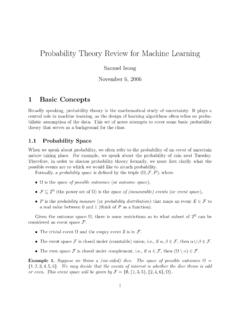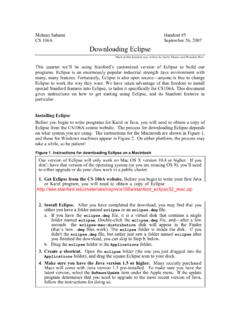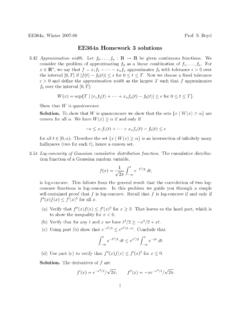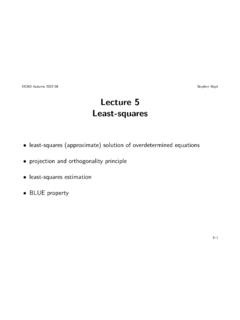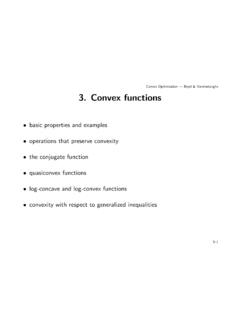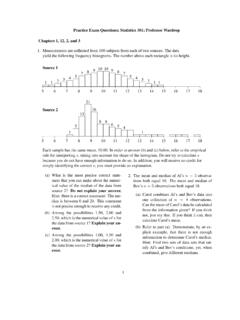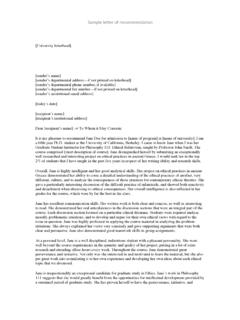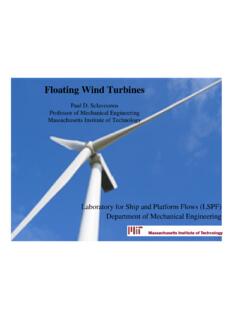Transcription of -dimensional Fourier Transform
1 Chapter 8. n -dimensional Fourier Transform Space, the Final Frontier To quote Ron Bracewell from p. 119 of his book Two -dimensional Imaging, In two dimensions phenomena are richer than in one dimension. True enough, working in two dimensions offers many new and rich possibilities. Contemporary applications of the Fourier Transform are just as likely to come from problems in two, three, and even higher dimensions as they are in one imaging is one obvious and important example. To capitalize on the work we've already done, however, as well as to highlight differences between the one- dimensional case and higher dimensions, we want to mimic the one -dimensional setting and arguments as much as possible. It is a measure of the naturalness of the fundamental concepts that the extension to higher dimensions of the basic ideas and the mathematical definitions that we've used so far proceeds almost automatically.
2 However much we'll be able to do in class and in these notes, you should be able to read more on your own with some assurance that you won't be reading anything too much different from what you've already read. Notation The higher dimensional case looks most like the one -dimensional case when we use vector notation. For the sheer thrill of it, I'll give many of the definitions in n dimensions, but to raise the comfort level we'll usually look at the special case of two dimensions in more detail; two and three dimensions are where most of our examples will come from. We'll write a point in Rn as an n-tuple, say x = (x1 , x2 , .. , xn ) . Note that we're going back to the usual indexing from 1 to n. (And no more periodic extensions of the n-tuples either!) We'll be taking Fourier transforms and may want to assign a physical meaning to our variables, so we often think of the xi 's as coordinates in space, with the dimension of length, and x as the spatial variable.
3 We'll then also need an n-tuple of frequencies , and without saying yet what frequency means, we'll (typically) write = ( 1 , 2 , .. , n ). for those variables dual to x . Recall that the dot product of vectors in Rn is given by x = x1 1 + x2 2 + + xn n . The geometry of Rn is governed by the dot product, and using it will greatly help our understanding as well as streamline our notation. 336 Chapter 8 n -dimensional Fourier Transform The Fourier Transform We started this course with Fourier series and periodic phenomena and went on from there to define the Fourier Transform . There's a place for Fourier series in higher dimensions, but, carrying all our hard won experience with us, we'll proceed directly to the higher dimensional Fourier Transform . I'll save Fourier series for a later section that includes a really interesting application to random walks.
4 How shall we define the Fourier Transform ? We consider real- or complex-valued functions f defined on Rn , and write f (x) or f (x1 , .. , xn ), whichever is more convenient in context. The Fourier Transform of f (x) is the function Ff ( ), or f ( ), defined by Z. Ff ( ) = e 2 ix f (x) dx . Rn The inverse Fourier Transform of a function g( ) is Z. F 1 g(x) = e2 ix g( ) d . n R. The Fourier Transform , or the inverse Transform , of a real-valued function is (in general) complex valued. The exponential now features the dot product of the vectors x and ; this is the key to extending the definitions from one dimension to higher dimensions and making it look like one dimension. The integral is over all of Rn , and as an n-fold multiple integral all the xj 's (or j 's for F 1 ) go from to.
5 Realize that because the dot product of two vectors is a number, we're integrating a scalar function, not a vector function. Overall, the shape of the definitions of the Fourier Transform and the inverse Transform are the same as before. The kinds of functions to consider and how they enter into the discussion Schwartz functions, L1 , L2 , etc. is entirely analogous to the one -dimensional case, and so are the definitions of these types of functions. Because of that we don't have to redo distributions et al. (good news), and I'll seldom point out when this aspect of the general theory is (or must be) invoked. Written out in coordinates, the definition of the Fourier Transform reads: Z. Ff ( 1 , 2 , .. , n ) = e 2 i(x1 1 + +xn n ) f (x1 , .. , xn ) dx1 .. dxn , Rn so for two dimensions, Z Z.
6 Ff ( 1 , 2 ) = e 2 i(x1 1 +x2 2 ) f (x1 , x2 ) dx1 dx2 .. The coordinate expression is manageable in the two -dimensional case, but I hope to convince you that it's almost always much better to use the vector notation in writing formulas, deriving results, and so on. Arithmetic with vectors, including the dot product, is pretty much just like arithmetic with numbers. Consequently, all of the familiar algebraic properties of the Fourier Transform are present in the higher dimensional setting. We won't go through them all, but, for example, Z Z. Ff ( ) = e 2 ix ( ) f (x) dx = e2 ix f (x) dx = F 1 f ( ) , Rn Rn which is one way of stating the duality between the Fourier and inverse Fourier transforms. Here, recall that if = ( 1 , .. , n ) then = ( 1 , .. , n ) . Space, the Final Frontier 337.
7 To be neater, we again use the notation f ( ) = f ( ) , and with this definition the duality results read exactly as in the one -dimensional case: Ff = (Ff ) , (Ff ) = F 1 f In connection with these formulas, I have to point out that changing variables, one of our prized techniques in one dimension, can be more complicated for multiple integrals. We'll approach this on a need to know basis. It's still the case that the complex conjugate of the integral is the integral of the complex conjugate, so when f (x) is real valued, Ff ( ) = Ff ( ) . Finally, evenness and oddness are defined exactly as in the one -dimensional case. That is: f (x) is even if f ( x) = f (x), or without writing the variables, if f = f . f (x) is odd f ( ) = f ( ), or f = f . Of course, we no longer have quite the easy geometric interpretations of evenness and oddness in terms of a graph in the higher dimensional case as we have in the one -dimensional case.
8 But as algebraic properties of a function, these conditions do have the familiar consequences for the higher dimensional Fourier Transform , , if f (x) is even then Ff ( ) is even, if f (x) is real and even then Ff ( ) is real and even, etc. You could write them all out. I won't. Soon enough we'll calculate the Fourier Transform of some model functions, but first let's look a little bit more at the complex exponentials in the definition and get a better sense of what the spectrum means in higher dimensions. Harmonics, periodicity, and spatial frequencies The complex exponentials are again the building blocks the harmonics for the Fourier Transform and its inverse in higher dimensions. Now that they involve a dot product, is there anything special we need to know? As mentioned just above, we tend to view x = (x1.)
9 , xn ) as a spatial variable and = ( 1 , .. , n ). as a frequency variable. It's not hard to imagine problems where one would want to specify n spatial dimensions each with the unit of distance, but it's not so clear what an n-tuple of frequencies should mean. One thing we can say is that if the spatial variables (x1 , .. , xn ) do have the dimension of distance then the corresponding frequency variables ( 1 , .. , n ) have the dimension 1/distance. For then x = x1 1 + + xn n is dimensionless and exp( 2 ix ) makes sense. This corresponds to dimensions of time and 1/time in the one -dimensional time domain and frequency domain picture. For some further insight let's look at the two -dimensional case. Consider exp( 2 ix ) = exp( 2 i(x1 1 + x2 2 )) . 338 Chapter 8 n -dimensional Fourier Transform (It doesn't matter for the following discussion whether we take + or in the exponent.
10 The exponent equals 1 whenever x is an integer, that is, when 1 x1 + 2 x2 = n, n an integer . With = ( 1 , 2 ) fixed this is a condition on (x1 , x2 ), and one says that the complex exponential has zero phase whenever 1 x1 + 2 x2 is an integer. This terminology comes from optics. There's a natural geometric interpretation of the zero phase condition that's very helpful in understanding the most important properties of the complex exponential. For a fixed the equations 1 x1 + 2 x2 = n determine a family of parallel lines in the (x1 , x2 )-plane (or in the spatial domain if you prefer that phrase). Take n = 0. Then the condition on x1 and x2 is 1 x1 + 2 x2 = 0. and we recognize this as the equation of a line through the origin with ( 1 , 2 ) as a normal vector to the (Remember your vectors!)
